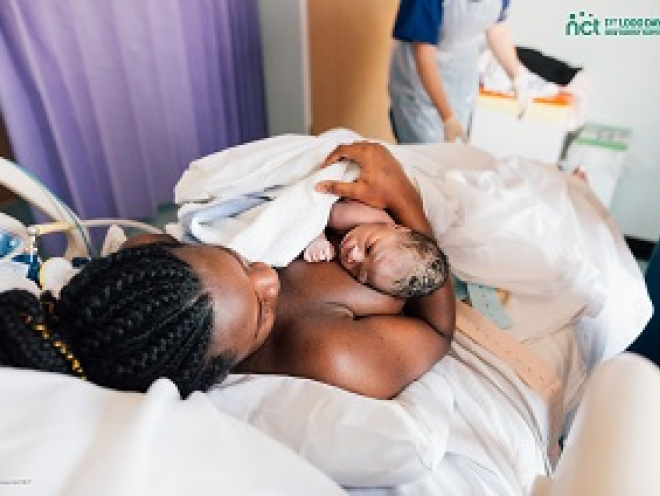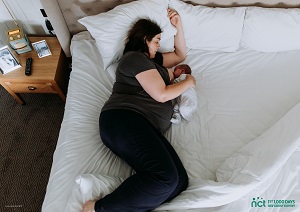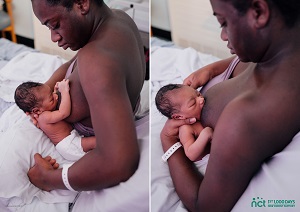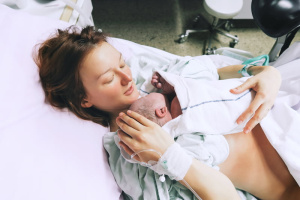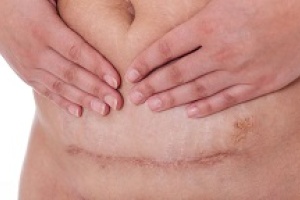A caesarean birth can affect breastfeeding at first so here are some helpful tips on how to get breastfeeding off to the best start.
Some evidence suggests that mums who give birth by caesarean can find it more difficult to establish breastfeeding and are more likely to stop breastfeeding earlier. But other research has found that the type of birth has very little effect on the numbers of mums still breastfeeding when their babies are six months old (Prior et al, 2012; Hobbs et al, 2016).
We discuss why a caesarean birth might make breastfeeding more difficult. And here are some helpful suggestions for breastfeeding your baby after a caesarean birth, including how some positions can make it easier.
How to get breastfeeding off to a good start after a caesarean birth
Skin-to-skin contact between mum and baby are recommended immediately after birth (NICE, 2021; UNICEF, no date). This means your baby is placed naked onto your bare chest. This helps babies adjust to the world, begin bonding and start breastfeeding.
Babies in skin-to-skin contact with their mums soon after birth are more likely to have a successful first feed and are more likely to be breastfeeding at four months (Moore et al, 2016). Mums who give birth by caesarean are more likely to stop breastfeeding earlier than those who give birth vaginally (Hobbs et al, 2016). Yet there is no difference in breastfeeding rates with different types of birth in babies who have early skin-to-skin contact (Lau et al, 2018).
Skin-to-skin contact within the first hour after a caesarean birth is more challenging, but mums who request this – and who are supported by health professionals to achieve this – are more likely to have a positive outcome (Stevens et al, 2018). Guidelines on caesarean birth recommend that women who want to breastfeed should be supported to have skin-to-skin contact with their babies as soon as possible after birth (NICE, 2021).
The many benefits for you and your baby of holding them skin-to-skin include:
- helping with bonding
- increasing levels of oxytocin, which is important for breastfeeding
- giving the baby time to have their first breastfeed
- mums say that it feels right and can help with feeling calmer.
(Stevens et al, 2019)
If a baby can’t have skin-to-skin contact with their mum, skin-to-skin with the other parent is also beneficial (UNICEF, 2019b).
Tips: how to get the breastfeeding support you need after a caesearean
After a caesarean birth, early skin-to-skin contact should be encouraged and extra support offered (Beake et al, 2017; NICE, 2021). Extra support could include the following…
- Getting comfortable
You can ask your midwife to help you to find positions that are comfortable for breastfeeding (NICE, 2021).
- Feeding support
Your midwife or someone on the infant feeding team should support you with keeping your baby as close to you as possible. They should also support you to help your baby to have as much skin-to-skin contact and access to your breasts as possible (NICE, 2021).
They can check whether your baby is latching effectively, especially if they’re drowsy from medication. They’ll also help to make sure your baby feeds frequently and will continue to support you with breastfeeding your newborn.
If your baby is unable to breastfeed directly, they should show you how to express your milk. This is so that your baby can have your milk and your milk supply will be maintained (UNICEF, 2014).
- Pain relief
Women do experience pain after a caesarean birth, which can have a negative effect on establishing breastfeeding. It is usually necessary to take pain relief. It's fine to take paracetamol and ibuprofen to help with the pain but aspirin and codeine are not recommended when breastfeeding (Karlström et al, 2007; NICE, 2021).
- An accurate birth weight
Babies born by caesarean absorb some of the IV fluids given to the mum during surgery, increasing the baby's weight at birth. These babies urinate more in the first 24 hours, which restores their weight to normal. That means it’s more accurate for babies born by caesarean to have their birth weight recorded at 24 hours and for this to be used as a baseline to compare their progress with (UNICEF, 2019).
- Time
Do give yourself and your baby time to adjust, you’ve just been through an amazing but huge change in your life and your baby needs time to get used to life outside the womb. Plus, it takes time for you and your baby to recover physically from the caesarean birth and from any medications you had (NICE, 2019).
- Practical help
Do accept all offers of help and certainly don’t be afraid to ask for it – you’ve just had an operation and a baby after all. Help isn’t just good for you, it’s good for your baby too. Research says that mums who ‘look after themselves’ by asking for more help are more likely to breastfeed for longer (Tully and Ball, 2014).
Breastfeeding positions
It’s important to find a breastfeeding position that’s comfortable for both you and your baby. This helps your baby to latch well and helps you to maintain the position for as long as your baby is feeding.
Some mums like to cover their caesarean scar to protect it, others prefer positions that keep their baby away from it. Some mums find the position of the cannula in their hand or arm from the caesarean can affect how easy it is to find a comfortable breastfeeding position. So it might be worth discussing this with midwives or breastfeeding supporters.
When your baby is breastfeeding, they should come to your breast chin first, nipple pointing up the nose, body in a straight line, nipple aimed towards the roof of their mouth and their body very close to you. Read our article How to help your baby attach and breastfeed for more information.
Here are some positions you could try…
Lying down on your side
This position can be quite restful as well as keeping pressure away from your scar. If you’re using a pillow for your head or a duvet, they need to be kept away from your baby.
- Some mums find it helpful to have pillows and cushions supporting their back or between their knees. If you have larger breasts, you could try lying on a thin cushion or folded towel.
- Once you’re in position, your baby can be placed close to you so you’re facing each other
- You can guide your baby using your free hand.
- Try to make sure you bring your baby to the breast rather than leaning over to post the breast into the baby’s mouth.
- You might need help to roll over to feed from the other breast.
Laid-back breastfeeding
This position helps to trigger a baby’s instincts to position themselves and latch on to breastfeed. It can also be a very restful breastfeeding position because you don’t have to sit upright and your body supports your baby’s weight.
With baby’s cheek resting on your chest, you can put your baby face down onto your body wherever it feels comfortable. This might be diagonally across your body so your baby is away from your scar. Then you can relax and enjoy the cuddle with your baby.
For more details about what laid-back breastfeeding is and the ideas behind it, see our article here.
Rugby-ball or underarm position
This position might help to keep your baby away from your scar. For more on how to breastfeed in this position, see our article about breastfeeding positions.
If using this position after a caesarean, you might find it helpful to have pillows behind you to help support your back. You might also want to place a pillow under your arm to help to support your baby’s weight; this is best done after baby has latched on.
Try to bring the baby to your breast rather than leaning forward to post your breast into their mouth as this achieves a deeper latch, which is more sustainable during a feed. It will stop you getting an aching back.
Why a caesarean birth might make breastfeeding more difficult
Frequent, effective removal of milk from a mum’s breasts ensures she produces the amount of milk her baby needs. That’s because the more milk your baby takes, the higher your levels of breastfeeding hormones (prolactin and oxytocin) will be and the more milk you’ll make. We also know that the earlier breastfeeding starts, the more likely it is to continue. A caesarean birth could affect this in a variety of ways…
- Pain - from the scar and from the baby not latching well at the breast because the mum finds it harder to get comfortable (Tully and Bull, 2014). This could cause her not to feed as often or for as long.
- Loss of mobility - can make it harder to get into a comfortable position to feed and to pick the baby up when they want feeding (Tully and Bull, 2014).
- Not going through labour - if a mum has an elective caesarean birth before labour starts, she will not have produced labour hormones. This might lead to lower levels of breastfeeding hormones in the mother and babies being less prepared for feeding (Prior et al, 2012; Zanardo et al, 2013; Hobbs et al, 2016).
- Long and stressful labour - an emergency caesarean birth can leave women feeling tired and anxious for themselves and their baby. This stress can lead to lower levels of breastfeeding hormones (Hobbs et al, 2016).
- Exhaustion - in both mum and baby can lead to the baby feeding less often and less effectively.
- Medication - can lead to a mum feeling drowsy or unwell, which can make early breastfeeding less likely. Medication can also affect the baby, making them drowsy and less able to breastfeed effectively (Brown and Jordan, 2013; UNICEF, 2019).
- Separation - if mum and baby are separated, this can mean less chances for early breastfeeds.
- Less opportunities for early skin-to-skin and a delayed first breastfeed - caesarean births might mean less opportunities for skin-to-skin contact. Skin-to-skin contact and the baby having their first breastfeed as soon as possible after birth help breastfeeding to become established (Moore et al, 2016).
- Effects of a caesarean on the baby - babies born by caesarean are more likely to have mucous in their lungs, which can affect how interested they are in feeding (Tully and Ball, 2014). The IV fluids during labour can also boost a baby’s birth weight, which can lead to worries that they’ve lost too much weight and to early formula supplementation and less breastfeeding (Noel-Weiss, 2011; Chantry et al, 2014).
- Loss of confidence - mums might be less likely to believe their bodies can nurture and feed their baby and that breastfeeding is going well. Well-meaning family members might also be more likely to suggest a mum gives her baby formula (this makes breastfeeding more difficult) so she can rest after her caesarean. Early formula supplementation reduces a mother's milk production and confidence in her ability to feed her baby (Tully and Ball, 2014).
- Night feeds - feeding at night can be particularly difficult after a caesarean birth if family members or supporters are not available to help with picking the baby up. Some mums say they feel asking midwives for help is a sign of failure.
Take a look at our articles for more about the practicalities of recovering from a caesarean birth and for tips to help you recover more quickly.
This page was last reviewed in December 2021.
Further information
Our support line offers practical and emotional support with feeding your baby and general enquiries for parents, members and volunteers: 0300 330 0700.
You might find attending one of our NCT New Baby courses helpful as they give you the opportunity to explore different approaches to important parenting issues with a qualified group leader and other new parents in your area.
Make friends with other parents-to-be and new parents in your local area for support and friendship by seeing what NCT activities are happening nearby.
Beake S, Bick D, Narracott C, Chang YS. (2017) Interventions for women who have a caesarean birth to increase uptake and duration of breastfeeding: A systematic review. Matern Child Nutr. 13:e12390. Available at: https://www.ncbi.nlm.nih.gov/pubmed/27882659 [Accessed 30th December 2021]
Chantry C, Dewey K, Peerson J, Wagner E, Nommsen-Rivers L. (2014) In-hospital formula use increases early breastfeeding cessation among first-time mums intending to exclusively breastfeed. J Pediatr. 164:1339-1345. Available at: https://www.ncbi.nlm.nih.gov/pmc/articles/PMC4120190/ [Accessed 30th December 2021]
Hobbs A, Mannion C, McDonald S, Brockway M, Tough S. (2016) The impact of caesarean section on breastfeeding initiation, duration and difficulties in the first four months postpartum. BMC Pregnancy and Childbirth. 16:90. Available at: https://bmcpregnancychildbirth.biomedcentral.com/articles/10.1186/s1288… [Accessed 30th December 2021]
Karlström A, Engström-Olofsson R, Norbergh K-G, Sjöling M, Hildingsson I. (2007) Postoperative pain after cesarean birth affects breastfeeding and infant care. JOGNN. 36: 430-440. Available at: https://www.ncbi.nlm.nih.gov/pubmed/17880313 [Accessed 30th December 2021]
Lau Y, Tha PH, Ho-Lim SST, Wong LY, Peng IL, Nurfarah BZMC, et al. (2018) An analysis of the effects of intrapartum factors, neonatal characteristics, and skin-to-skin contact on early breastfeeding initiation. Matern Child Nutr. 14(1):e12492. Available at: https://www.ncbi.nlm.nih.gov/pmc/articles/PMC6866048/ [Accessed 30th December 2021]
Moore E, Bergman N, Anderson G, Medley N. (2016) Early skin-to-skin contact for mums and their healthy newborn infants’. Cochrane Database of Systematic Reviews. (11):CD003519. Available at: https://www.cochranelibrary.com/cdsr/doi/10.1002/14651858.CD003519.pub4/full [Accessed 30th December 2021]
NICE. (2021) NG192 Caesarean birth. Available at https://www.nice.org.uk/guidance/ng192/chapter/Recommendations#care-of-… [Accessed 30th December 2021]
Noel-Weiss J, Woodend AK, Peterson WE, Gib W, Groll DL. (2011) An observational study of associations among maternal fluids during parturition, neonatal output, and breastfed newborn weight loss. Int Breastfeed J. 6:9. Available at: http://www.internationalbreastfeedingjournal.com/content/6/1/9 [Accessed 30th December 2021]
O’Brien M, Buikstra E, Fallon T, Hegney D. (2009) Strategies for success: a toolbox of coping strategies used by breastfeeding women. J Clin Nurs. 18:1574-1582. Available at: https://www.ncbi.nlm.nih.gov/pubmed/19220615 [Accessed 30th December 2021]
Prior E, Santhakumaran S, Gale C, Philipps L, Modi N, Hyde M. (2012) Breastfeeding after caesarean delivery: a systematic review and meta-analysis of world literature. Am J Clin Nutr. 95(5):1113-1135. Available at: https://www.ncbi.nlm.nih.gov/pubmed/22456657 [Accessed 30th December 2021]
Stevens J, Schmied V, Burns E, Dahlen HG. (2018) Who owns the baby? A video ethnography of skin-to-skin contact after a caesarean section. Women Birth. 31(6):453-462. Available at: https://pubmed.ncbi.nlm.nih.gov/29496385/ [Accessed 30th December 2021]
Stevens J, Schmied V, Burns E, Dahlen H. (2019) Skin-to-skin contact and what women want in the first hours after a caesarean section. Midwifery. 74:140-146. Available at: https://www.ncbi.nlm.nih.gov/pubmed/30954633 [Accessed 30th December 2021]
Tully K, Ball H. (2014) Maternal accounts of their breast-feeding intent and early challenges after caesarean childbirth. Midwifery. 30:712-719. Available at: https://www.ncbi.nlm.nih.gov/pmc/articles/PMC4451198/ [Accessed 30th December 2021]
UNICEF. (no date) Skin-to-skin contact. Available at: https://www.unicef.org.uk/babyfriendly/baby-friendly-resources/implemen… [Accessed 30th December 2021]
UNICEF (2014) The Baby Friendly Initiative – The ten steps to successful breastfeeding. Available at: https://www.unicef.org.uk/babyfriendly/wp-content/uploads/sites/2/2014/… [accessed 30th December 2021]
UNICEF. (2019) Research on skin-to-skin contact. Available at: https://www.unicef.org.uk/babyfriendly/news-and-research/baby-friendly-research/research-supporting-breastfeeding/skin-to-skin-contact/ [Accessed 30th December 2021]
